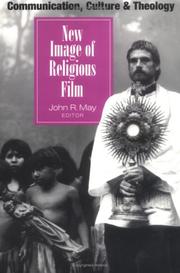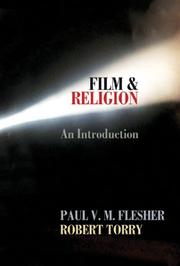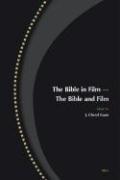| Listing 1 - 10 of 32 | << page >> |
Sort by
|
Book
ISBN: 147254949X 1280581085 9786613610867 1441147926 9781441147929 9781441161703 1441161708 9781472533029 9781280581083 6613610860 Year: 2012 Publisher: New York : Continuum,
Abstract | Keywords | Export | Availability | Bookmark
 Loading...
Loading...Choose an application
- Reference Manager
- EndNote
- RefWorks (Direct export to RefWorks)
"For more than half a century now, scholars have debated over what comprises a 'genuinely' religious film one that evinces an 'authentic' manifestation of the sacred. Often these scholars do so by pitting the 'successful' films against those which propagate an inauthentic spiritual experience with the biblical spectacular serving as their most notorious candidate. This book argues that what makes a filmic manifestation of the sacred true or authentic may say more about a spectator or critic's particular way of knowing, as influenced by alphabetic literacy, than it does about the aesthetic or philosophical and sometimes even faith-based dimensions of the sacred onscreen. Engaging with everything from Hollywood religious spectaculars, Hindu mythologicals, and an international array of films revered for their 'transcendental style,' The Sacred and the Cinema unveils the epistemic pressures at the heart of engaging with the sacred onscreen. The book also provides a valuable summation of the history of the sacred as a field of study, particularly as that field intersects with film."--Bloomsbury Publishing.
Motion pictures --- Religion in motion pictures. --- Religious films --- Religion and motion pictures --- Religious aspects.

ISBN: 1556127618 Year: 1997 Publisher: Franklin Sheed and Ward.
Abstract | Keywords | Export | Availability | Bookmark
 Loading...
Loading...Choose an application
- Reference Manager
- EndNote
- RefWorks (Direct export to RefWorks)
Motion pictures --- Religious films --- Religious aspects --- Congresses --- History and criticism --- Congresses
Book
ISBN: 0313013985 0313330727 9780313013980 9780313330728 Year: 2011 Publisher: Santa Barbara, Calif. ABC-CLIO
Abstract | Keywords | Export | Availability | Bookmark
 Loading...
Loading...Choose an application
- Reference Manager
- EndNote
- RefWorks (Direct export to RefWorks)
Motion pictures --- Religion in motion pictures --- Religious films --- Religious aspects --- History and criticism
Book
ISBN: 9781138647497 1138647497 9781138718647 1138718645 9781138718654 1138718653 9781138718661 1138718661 9781138718678 113871867X Year: 2017 Publisher: Milton Park, Abingdon, Oxon New York, NY Routledge
Abstract | Keywords | Export | Availability | Bookmark
 Loading...
Loading...Choose an application
- Reference Manager
- EndNote
- RefWorks (Direct export to RefWorks)
Motion pictures --- Religion in motion pictures --- Religious films --- Religious aspects --- History and criticism
Book
ISBN: 9780826499912 0826499910 Year: 2009 Publisher: London Continuum
Abstract | Keywords | Export | Availability | Bookmark
 Loading...
Loading...Choose an application
- Reference Manager
- EndNote
- RefWorks (Direct export to RefWorks)
Religious films --- Motion pictures --- -Religion in motion pictures --- History and criticism --- Religious aspects

ISBN: 9780687334896 0687334896 Year: 2007 Publisher: Nashville, TN: Abingdon press,
Abstract | Keywords | Export | Availability | Bookmark
 Loading...
Loading...Choose an application
- Reference Manager
- EndNote
- RefWorks (Direct export to RefWorks)
Sociology of religion --- Film --- Films religieux --- Motion pictures --- Religious films --- Religious aspects. --- History and criticism. --- Cinéma --- Aspect religieux --- Histoire et critique --- Motion pictures - Religious aspects. --- Religious films - History and criticism.
Book
ISBN: 1438470185 9781438470184 9781438470177 1438470177 Year: 2018 Publisher: Albany : State University of New York Press,
Abstract | Keywords | Export | Availability | Bookmark
 Loading...
Loading...Choose an application
- Reference Manager
- EndNote
- RefWorks (Direct export to RefWorks)
For some time now, thinkers across the humanities and social sciences have increasingly called into question the once-dominant view of the relationship between modernity and secularism, prompting some to speak of a "postsecular turn." Until now, film studies has largely been silent about this development, even though cinema itself has been a major vehicle for such reflection. This fact became inescapable in 2011 when Terrence Malick's The Tree of Life and Lars von Trier's Melancholia were released within days of each other. While these two audacious and controversial films present seemingly opposite perspectives—the former a thoughtful meditation on faith, the latter a portrayal of nontriumphalist atheism—together they raise critical questions about transcendence and immanence in modern life. These films are, however, only the most conspicuous of a growing body of works that call forth similar and related questions—what this collection aptly calls "postsecular cinema."Taking the nearly simultaneous release of The Tree of Life and Melancholia as its starting point and framing device, this pioneering collection sets out to establish the idea of postsecular cinema as a distinct body of films and a viable critical category. Adopting a film-philosophy approach, one group of essays examines Malick's and von Trier's films, while another looks at works by Chantal Akerman, Denys Arcand, the Dardenne brothers, and John Michael McDonagh, among others. The volume closes with two important interviews with Luc Dardenne and Jean-Luc Nancy that invite us to reflect more deeply on some of the central concerns of postsecular cinema.

ISBN: 1281399507 9786611399504 9047409876 9789047409878 9789004151901 9004151907 9789047409878 9781281399502 661139950X Year: 2006 Publisher: Leiden Boston Brill
Abstract | Keywords | Export | Availability | Bookmark
 Loading...
Loading...Choose an application
- Reference Manager
- EndNote
- RefWorks (Direct export to RefWorks)
Biblical scholars and students are finding the role of the Bible in film an increasingly absorbing and rewarding topic. There are films that retell biblical narratives and there are films that allude to the Bible or otherwise build on or appropriate biblical themes and images. The eleven lively and provocative articles in this volume explore both types of film, showcasing the cinema's impact on the perception of the Bible in modern culture. Originally published as issue 1-2 of Volume 14 (2006) of Brill's journal Biblical Interpretation. For more details on this journal, please click here.
Bible films --- Biblical films --- Religious films --- History and criticism. --- Bible --- In motion pictures. --- In motion pictures --- Bible films - History and criticism.
Book
ISBN: 0292754736 0292754728 Year: 2014 Publisher: Austin, Texas : University of Texas Press,
Abstract | Keywords | Export | Availability | Bookmark
 Loading...
Loading...Choose an application
- Reference Manager
- EndNote
- RefWorks (Direct export to RefWorks)
From struggles over identity politics in the 1990s to current concerns about a clash of civilizations between Islam and Christianity, culture wars play a prominent role in the twenty-first century. Movies help to define and drive these conflicts by both reflecting and shaping cultural norms, as well as showing what violates those norms. In this pathfinding book, Daniel S. Cutrara employs queer theory, cultural studies, theological studies, and film studies to investigate how cinema represents and often denigrates religion and religious believers—an issue that has received little attention in film studies, despite the fact that faith in its varied manifestations is at the heart of so many cultural conflicts today. Wicked Cinema examines films from the United States, Europe, and the Middle East, including Crimes and Misdemeanors, The Circle, Breaking the Waves, Closed Doors, Agnes of God, Priest, The Last Temptation of Christ, and Dogma. Central to all of the films is their protagonists’ struggles with sexual transgression and traditional belief systems within Christianity, Judaism, or Islam—a struggle, Cutrara argues, that positions believers as the Other and magnifies the abuses of religion while ignoring its positive aspects. Uncovering a hazardous web of ideological assumptions informed by patriarchy, the spirit/flesh dichotomy, and heteronormativity, Cutrara demonstrates that ultimately these films emphasize the “Otherness” of the faithful through a variety of strategies commonly used to denigrate the queer, from erasing their existence, to using feminization to make them appear weak, to presenting them as dangerous fanatics.
Sex in motion pictures. --- Religion in motion pictures. --- Motion pictures --- Moral and ethical aspects. --- Religious films --- Sex in moving-pictures --- Erotic films --- Pornographic films
Book
ISBN: 9781405160254 140516025X 9781405160261 1405160268 Year: 2009 Volume: 4 Publisher: Malden Wiley-Blackwell
Abstract | Keywords | Export | Availability | Bookmark
 Loading...
Loading...Choose an application
- Reference Manager
- EndNote
- RefWorks (Direct export to RefWorks)
Christian religion --- Film --- Religious films --- Religion in motion pictures. --- History and criticism. --- 791.43:2 --- Motion pictures --- Religion in motion pictures --- Film en religie. Film en godsdienst --- 791.43:2 Film en religie. Film en godsdienst --- History and criticism --- Religious films - History and criticism.
| Listing 1 - 10 of 32 | << page >> |
Sort by
|

 Search
Search Feedback
Feedback About UniCat
About UniCat  Help
Help News
News